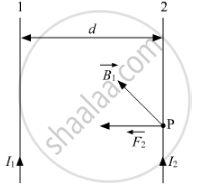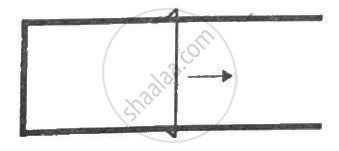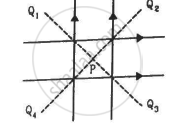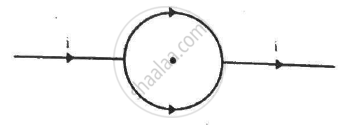Advertisements
Advertisements
Question
Two infinitely long straight parallel wires, '1' and '2', carrying steady currents I1 and I2 in the same direction are separated by a distance d. Obtain the expression for the magnetic field `vecB`due to the wire '1' acting on wire '2'. Hence find out, with the help of a suitable diagram, the magnitude and direction of this force per unit length on wire '2' due to wire '1'. How does the nature of this force changes if the currents are in opposite direction? Use this expression to define the S.I. unit of current.
Solution
Consider a straight conductor XY lying in the plane of paper. Consider a point P at a perpendicular distance a from straight conductor.

Magnetic field induction (B) at a point P due to current I passing through conductor XY is given by
`B=(μ0I)/(4πa)[sinϕ_1+sinϕ_2]`
where ϕ1 and ϕ2 are the angles made by point X and Y, respectively
At the centre of the infinite long wire, ϕ1=ϕ2=90°
`B=(μ_0I)/(4πa)[sin90^@+sin^@]`
`⇒B=μ_0/(4π) (2I)/a .....(1)`

Let 1 and 2 be two long infinite straight conductors. Let I1 and I2 be the current flowing through the conductor 1 and 2 and they are d distance apart from each other as shown in the figure.
The magnetic field induction (B) at a point P on conductor 2 due to current I1 passing through conductor 1 is given by
`B=(μ_02I_1)/(4πd) ` [From (1), where a=d]
According to right hand rule, the direction of this magnetic field is perpendicular to the plane of the paper inward.
Since the conductor 2 lies in this magnetic field of conductor 1, force experienced (F2) by unit length of conductor 2 will be
F2=B1I2×1=B1I2
`∴ F2=μ_0/(4π) (2I_1I_2)/d`
Conductor 1 also experiences the same amount of force, directed towards the conductor 2. Hence, conductor 1 and conductor 2 attract each other. Thus, two linear parallel conductors carrying currents in the same direction attract and repel each other, when the current flows in the opposite direction.
Let I_1=I_1=1A; r=1 m
Then,
`F_1=F_2=F=10^(−7) (2xx1xx1)/1`
`⇒F=2×10^(−7) N/m`
Thus, one ampere is that value of constant current which when flowing through each of the two parallel uniform long linear conductors placed in free space at a distance of 1 m from each other will attract or repel each other with a force of 2 × 10−7 N per metre of their length.
APPEARS IN
RELATED QUESTIONS
Using the concept of force between two infinitely long parallel current carrying conductors, define one ampere of current.
A charged particle goes undeflected in a region containing an electric and a magnetic field. It is possible that
(a) `vecE" || "vecB , vecv" || " vec E `
(b) `vecE "is not parallel" vecB`
(c) `vecv " || " vecB but vecv "is not parallel"`
(d) `vecE" || " vecB but vecv "is not parallel"`
A long, straight wire of radius R carries a current distributed uniformly over its cross section. T he magnitude of the magnetic field is
(a) maximum at the axis of the wire
(b) minimum at the axis of the wire
(c) maximum at the surface of the wire
(d) minimum at the surface of the wire.
The magnetic field existing in a region is given by `vecB = B_0(1 + x/1)veck` . A square loop of edge l and carrying a current i, is placed with its edges parallel to the x−y axes. Find the magnitude of the net magnetic force experienced by the loop.
Figure shows a metallic wire of resistance 0.20 Ω sliding on a horizontal, U-shaped metallic rail. The separation between the parallel arms is 20 cm. An electric current of 2.0 µA passes through the wire when it is slid at a rate of 20 cm s−1. If the horizontal component of the earth's magnetic field is 3.0 × 10−5 T, calculate the dip at the place.

Four long, straight wires, each carrying a current of 5.0 A, are placed in a plane as shown in figure. The points of intersection form a square of side 5.0 cm.
(a) Find the magnetic field at the centre P of the square.
(b) Q1, Q2, Q3, and Q4, are points situated on the diagonals of the square and at a distance from P that is equal to the diagonal of the square. Find the magnetic fields at these points.

Two parallel wires separated by a distance of 10 cm carry currents of 10 A and 40 A along the same direction. Where should a third current by placed so that it experiences no magnetic force?
A conducting circular loop of radius a is connected to two long, straight wires. The straight wires carry a current i as shown in figure. Find the magnetic field B at the centre of the loop.

The nature of parallel and anti-parallel currents are ______.
Three infinitely long parallel straight current-carrying wires A, B and C are kept at equal distance from each other as shown in the figure. The wire C experiences net force F. The net force on wire C, when the current in wire A is reversed will be ______.

